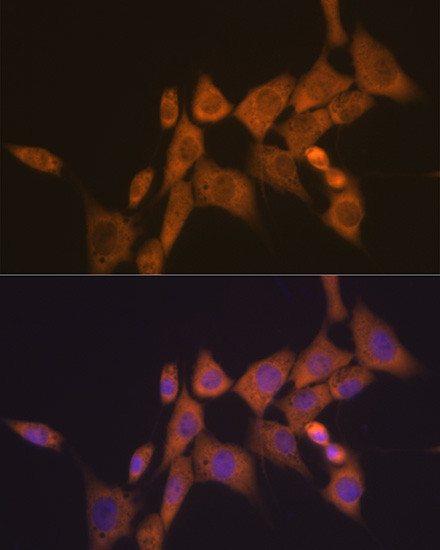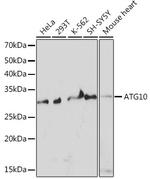Search Thermo Fisher Scientific
Product Details
MA5-38164
Species Reactivity
Host/Isotype
Expression System
Class
Type
Clone
Immunogen
Conjugate
Form
Concentration
Purification
Storage buffer
Contains
Storage conditions
Shipping conditions
RRID
Product Specific Information
Positive Samples: HeLa, 293T, K-562, SH-SY5Y, Mouse heart
Immunogen sequence: RPLTLKDIWE GVHECYKMRL LQGPWDTITQ QEHPILGQPF FVLHPCKTNE FMTPVLKNSQ KINKNVNYIT SWLSIVGPVV GLNLPLSYAK ATSQDERNVP
Target Information
ATG10 is involved in autophagy which is a process for the bulk degradation of cytosolic compartments by lysosomes/vacuoles. The formation of autophagosomes involves a dynamic rearrangement of the membrane for which two ubiquitin-like modifications (the conjugation of APG12p and the modification of a soluble form of MAP-LC3 to a membrane-bound form) are essential. APG10 is an E2-like enzyme involved in two ubiquitin-like modifications essential for autophagosome formation, ATG12 -ATG5 conjugation and modification of a soluble form of MAP-LC3 (MAP1LC3A), a homolog of yeast Apg8, to a membrane-bound form. The protein ATG10 is ubiquitously expressed and the human APG10L gene is localized on chromosome 5q14.2.
For Research Use Only. Not for use in diagnostic procedures. Not for resale without express authorization.
References (0)
Bioinformatics
Protein Aliases: APG10-like; ATG10 autophagy related 10 homolog; autophagy-related 10; Autophagy-related protein 10; DKFZp586I0418; FLJ13954; mAPG10; Ubiquitin-like-conjugating enzyme ATG10
Gene Aliases: 5330424L23Rik; 5430428K15Rik; Agp10; AI852123; APG10; APG10L; Apg10p; ATG10; Atg10l; PP12616
UniProt ID: (Human) Q9H0Y0, (Mouse) Q8R1P4
Entrez Gene ID: (Human) 83734, (Mouse) 66795

Performance Guarantee
If an Invitrogen™ antibody doesn't perform as described on our website or datasheet,we'll replace the product at no cost to you, or provide you with a credit for a future purchase.*
Learn more
We're here to help
Get expert recommendations for common problems or connect directly with an on staff expert for technical assistance related to applications, equipment and general product use.
Contact tech support


